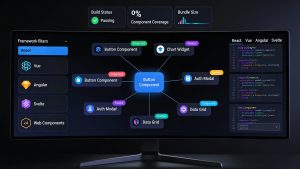Angular, developed and maintained by Google, is a powerful TypeScript-based front-end framework used to build scalable and robust single-page web applications. With its component-based architecture, dependency injection system, and built-in tooling, Angular remains a top choice for enterprises and developers working on complex frontend applications.
For experienced professionals, Angular interviews go far beyond basic syntax or lifecycle hooks—they dive into architectural decisions, performance optimization, testing, and advanced RxJS patterns. If you’re preparing for a mid- to senior-level Angular developer role, these are the questions you’re most likely to encounter—and the kind of in-depth answers that hiring managers expect.
Whether you’re building dashboards, e-commerce frontends, or enterprise-grade applications, this list will help sharpen your understanding and give you the confidence to handle tough interview rounds.
Most Frequently Asked Angular Interview Questions
1. What are Angular Modules and Why Are They Important?
Answer:
Modules in Angular help organize an application into cohesive blocks of functionality. Each Angular app has a root module (AppModule) and can have many feature modules. They declare which components, directives, and pipes belong to them and which of those can be reused in other modules using exports.
Why it’s important:
- Improves maintainability by grouping related functionality
- Supports lazy loading to improve performance
- Promotes reusability of code across the application
2. What is Ahead-of-Time (AOT) Compilation and How Does It Differ from Just-in-Time (JIT)?
Answer:
AOT compiles your Angular HTML and TypeScript code into efficient JavaScript code before the browser downloads and runs it, improving performance. In contrast, JIT compilation happens in the browser at runtime.
Benefits of AOT over JIT:
- Faster rendering
- Smaller Angular framework size
- Earlier template error detection
- Better security against injection attacks
Enable AOT with:
bash
ng build --prod3. Explain the Use of Dependency Injection in Angular
Answer:
Dependency Injection (DI) is a core design pattern in Angular where components receive their dependencies from an external source rather than creating them directly. Angular’s DI system provides service instances to components via constructors.
Example:
typescript
constructor(private userService: UserService) {}Advanced Tip:
You can provide services at different levels: root (singleton), component, or module level.
4. What Are Observables and How Are They Used in Angular?
Answer:
Observables (from RxJS) represent a stream of asynchronous data. Angular heavily uses observables for HTTP requests, form changes, and event handling.
Example:
typescript
this.http.get<User[]>('/api/users')
.subscribe(data => this.users = data);Why it’s important for experienced roles:
You may be asked about subjects like switchMap, mergeMap, debounceTime, or takeUntil for advanced reactive programming.
5. How Do You Optimize the Performance of an Angular Application?
Answer:
Key performance techniques include:
- Lazy loading modules
- Using OnPush change detection strategy
- Avoiding memory leaks via takeUntil and unsubscribe
- AOT compilation and tree shaking
- Minifying and compressing assets
Example: Using OnPush:
typescript
@Component({
changeDetection: ChangeDetectionStrategy.OnPush
})6. What Is the Role of NgModules vs Standalone Components (Angular 14+)?
Answer:
With Angular 14, developers can now build standalone components, which don’t require inclusion in NgModules. This simplifies structure and improves modularity.
Example:
typescript
@Component({
standalone: true,
selector: 'app-login',
templateUrl: './login.component.html',
imports: [FormsModule]
})
export class LoginComponent {}Use bootstrapApplication() instead of NgModule for bootstrapping.
7. How Do You Implement Route Guards?
Answer:
Route guards control access to certain routes based on conditions. Angular provides CanActivate, CanDeactivate, Resolve, and CanLoad interfaces.
Example:
typescript
@Injectable()
export class AuthGuard implements CanActivate {
constructor(private auth: AuthService) {}
canActivate(): boolean {
return this.auth.isLoggedIn();
}
}8. How Do You Manage State in Angular Applications?
Answer:
State can be managed using:
- Services with BehaviorSubject for simple state
- NgRx or Akita for complex state using Redux-like patterns
Example with BehaviorSubject:
typescript
private userSubject = new BehaviorSubject<User | null>(null);
user$ = this.userSubject.asObservable();
setUser(user: User) {
this.userSubject.next(user);
}Pro tip:
NgRx uses actions, reducers, selectors, and effects—important for large apps.
9. How Is Testing Done in Angular?
Answer:
Angular provides robust testing tools via:
- Karma (test runner)
- Jasmine (test framework)
- TestBed for unit testing components and services
Example unit test:
typescript
it('should create the component', () => {
const fixture = TestBed.createComponent(AppComponent);
const app = fixture.componentInstance;
expect(app).toBeTruthy();
});You should know how to test components with inputs, outputs, and mocked services.
10. What’s the Role of Interceptors in Angular?
Answer:
HTTP Interceptors allow you to intercept and modify HTTP requests/responses globally.
Use cases:
- Adding auth tokens
- Logging requests
- Error handling
Example:
typescript
intercept(req: HttpRequest<any>, next: HttpHandler): Observable<HttpEvent<any>> {
const authReq = req.clone({
setHeaders: { Authorization: `Bearer ${token}` }
});
return next.handle(authReq);
}Register it in the providers array using HTTP_INTERCEPTORS.
Conclusion
As Angular continues to evolve, so do the expectations from experienced developers. Interviewers today aren’t just assessing whether you know what an ngOnInit() does or how lazy loading works—they’re trying to gauge your real-world decision-making, your ability to architect scalable systems, and how you manage complexity in large, fast-moving projects.
To truly stand out, it’s not enough to simply memorize answers. You need to demonstrate thought leadership in your approach to development. Use this list of Angular interview questions and answers as a foundation, but take your preparation to the next level by doing the following:
- Build advanced Angular applications from scratch. Tackle full CRUD apps, integrate with real APIs, and deploy them using CI/CD pipelines. This gives you practical skills and stories to share in interviews.
- Explore Angular’s advanced features like custom structural directives, dynamic component loading, advanced form validation strategies, and state management patterns with NgRx or Akita.
- Stay current with Angular releases by reading changelogs, RFCs (Request for Comments), and the official Angular blog. This helps you speak confidently about why certain architectural changes were made—and how they affect your projects.
- Master RxJS beyond just Observable and subscribe(). Learn operators like switchMap, mergeMap, combineLatest, and shareReplay. Understand cold vs. hot observables, memory leaks, and proper unsubscribe patterns.
- Contribute to open-source projects or maintain your own Angular libraries and components. This not only showcases your skills but also proves your ability to collaborate at scale.
By taking these extra steps, you’ll position yourself not just as a candidate—but as a confident Angular expert capable of leading projects, mentoring teams, and making architectural decisions that drive real business value. Whether you’re applying to a startup or a Fortune 500 GCC, your depth and initiative will set you apart.
Prepare beyond the interview. Prepare for the role.
Talent500 is the go-to premium platform for ambitious tech professionals looking to work with the best global companies. Specializing in hiring for Global Capability Centres (GCCs) in India, Talent500 connects elite talent with Fortune 500 firms, global enterprises, and fast-growing startups.
Part of ANSR Global, a global market leader in GCC strategy and execution, Talent500 is trusted by industry leaders across sectors to build transformative teams that power innovation. If you’re looking to level up your tech career and work on challenging global-scale projects, Talent500 is the place to start.
Explore roles that match your ambition. Join the Talent500 community today.



